
QI (氣)
"Qi rides the wind and it is scattered, if it is bounded by water it is held."
Qi 氣 (pronounced as "chee"") is frequently translated as "natural energy," "life force," or "energy flow." The literal translation of Qi is "breath."There are three levels of Qi: Heaven, Earth and Man Qi. The interaction between these three levels of Qi governs and shapes our destiny.
In the Yi Jing (The Book of Changes, 1122 B.C.), Qi was described as the natural forces of Heaven, Earth and Man. These Three Powers (San Cai 三才) manifest as Heaven Qi (Tian Qi 天气) , Earth Qi (Di Q i地气), and Human Qi (Ren Qi 人气) with their definite rules and cycles. The rules are unchanging, while the cycles return to repeat themselves. The Yi Jing applies these principles to calculate changes in natural Qi, through a process called The Eight Trigrams (Bagua). From the Eight Trigrams are derived the 64 Hexagrams.
The Human Qi is controlled by Heaven Qi and Earth Qi and that they in fact determine a person's destiny. By understanding the relationship between nature and people, and also Human Relations (Ren Shi), one can predict conflicts. temperament, desires, and even their future. If you have a good understanding of how Qi functions and know how to regulate it correctly, you may live a long and healthy life since Qi is the source of life.
Earth Qi (Di Qi 地气) is the potential and kinetic energy stored in and under the ground. A simple way to tell if positive Qi resides in a particular area is to look at the vegetation--should be green and there is thriving wildlife. The energy of Feng Shui, however, can be good (Sheng Qi), weakening (Shi Qi), or harmful (Sha Qi).
Sheng Qi is life enhancing which brings forth feelings of contentment, happiness, and optimism. This is an upward and forward moving Qi in bright, positive and refresing locations often found in nature.
Shi Qi is the stagnant, depleting energy. It is found in buildings and the surrounding areas of a property.
Sha Qi refers to destruction and ruin and can come from a variety of sources. Any straight line, sharp structures, and certain structures such as pointed roof, electric pylons, a straight road that runs towards the front of your home or property, a T-junction, etc., can bring forth Sha Qi.
In Feng Shui practice, the idea is that Qi can be harnessed and directed by nature and its various elements, by the placement of objects of varous shapes and colors in different configurations, by sound and by the human mind (James Loretta, 2015).
FIVE ELEMENTS (五行 Wŭ Xíng)
The Five Element theory is the backbone of all Chinese Metaphysical studies. It is believed that all matters as well as the sentinent beings in our universe are composed by a blend of the Five Elements. It is this constant transformation and interaction that creates balance in the universe. Five Elements, however, are but a type of Qi and is the product of the interaction between the two fundamental universal forces: Ying and Yang. The types of Qi are named according to their attributes.

These elements also share three types of relationships known as "Cycles," through which an element can affect another. The three Cycles of Balance, a generating or creation (Sheng) cycle and an overcoming or destruction (Ke) cycle or interactions between the elements:
Productive Cycle
Water produces Wood
Wood produces Fire
Fire produces Earth
Earth produces Metal
Metal produces Water
The productive or generating cycle is a positive transformation. An element transform into the next by positive interaction, generating good results.
Controlling Cycle
Fire controls Metal
Metal controls Wood
Wood controls Earth
Earth controls Water
Water controls Fire
The Controlling Cycle occurs when an element counters the next leading to a more opposing and aggressive force.
Weakening Cycle
Water weakens Metal
Metal weakens Earth
Earth weakens Fire
Fire weakens Wood
Wood weakens Water
The Weakening Cycle occurs when one element drains the engergies from the next. Unlike the controlling cycle, the transformation is not aggressive and it is often the preferred way of countering an undeWhen using Feng Shui cures, it is always better to use the Weakening Cycle to lessen the negative effects of any element.
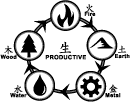
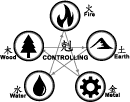
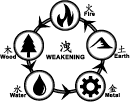
Yin and Yang
The concept of Ying Yang is associated in Chinese thought with the idea of the Five Elements--metal, water, fire and earth. The origins of the Yin Yang is ancient (700 BCE) and has permeated every aspect of Chinese thought, influencing astrology, divination, medicine, art, and government.
Looking at the image, you can see that although they are two opposite, they are complementary energies--Yin and Yang cannot exist without the other. The small dots within each of the two energies symbolize that there is always some Yin (black) within Yang (white) and vice versa. The interaction of Yin and Yang is reflected by Night and Day, Positive and Negative, Active and Passive, Hard and Soft, Fast and Slow, Male and Female, Hot and Cold, Anger and Happiness, etc.
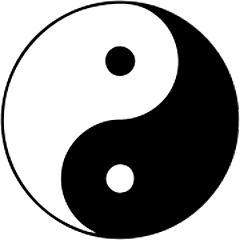
Bagua
The Bagua (Eight Symbols) is a system of trigrams designed by King Wen to described the nature of changes in the universe. Each consists of three lines, each either "broken" or "solid" reprenting a Yin line or a Yang line, often referred to as "trigrams" in English.
A trigram with two or more broken lines is primarily Yin, whereas a trigram with two or more solid lines is primarily Yang. Yin type trigrams are associate with receptive energy and stillness, while Yang type trigrams are associated with expansive energy action.
The patterns of changes represented in the post-celestial bagua can tell Feng Shui practitioner abou the type of energy--destructive or nourishing, that "enters" a particular position of a building at a particular time.
The Eight Trigrams

Fu Xi Bagua

King Wen Bagua
10 Heavenly Stems
There are 12 Earthly Branches and 10 Heavenly Stems: Jia (Wood), Yi (Wood), Bing (Fire), Ding (Fire), Wu (Earth), Ji (Earth), Geng (Metal), Xin (Metal), Ren (Water) and Gui (Water).
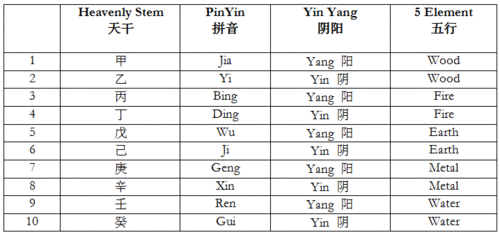
The I-Ching
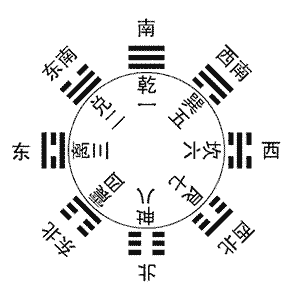
The I-Ching (易經), also known as the Classic of Changes or Book of Changes is probably the oldest Schools of Feng Shui. The I-Ching was originally a divination manual in the Western Zhou period, but over the course of the Warring States period and early imperial period, it evolved into a cosmological text with a series of philosophical commentaries known as the "Ten Wings."
The I-Ching uses a type of divination which produces random numbers: four numbers between 6 and 9 and turned into a hexagram. The resulting numbers can then be looked up in the I-Ching book (King Wen sequence) where the interpretation of the numbers is provided. Many people today, especially in Taiwan, use I-Ching divination to ask questions, make wishes or as a decision making tool. Visit a temple in Taiwan and you will find a container at the alter with 50 Yarrow sticks used for I-Ching divination. One ask a question (or pray), then pick a stick. Then, you take the book next to the container wher the meanings or interpretations of the numbers on the stick can be read.